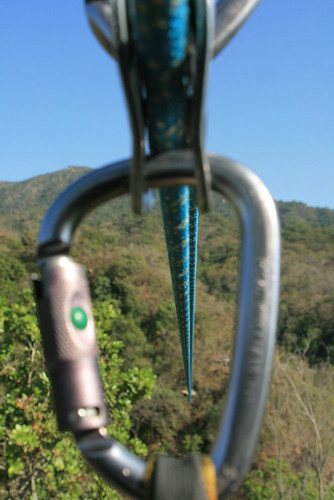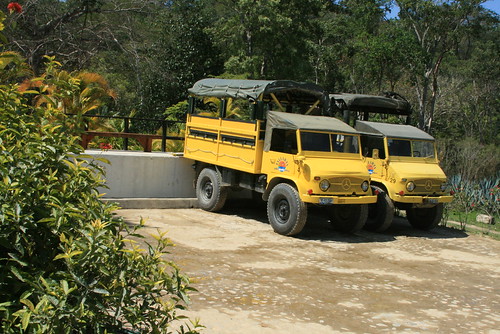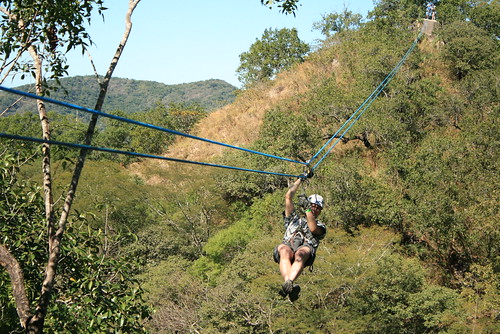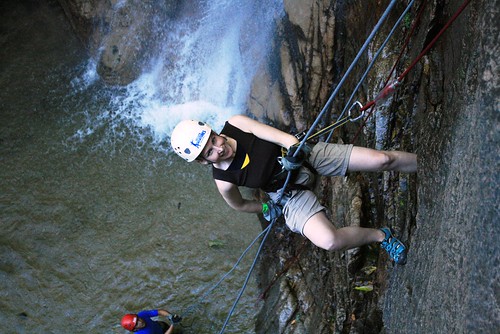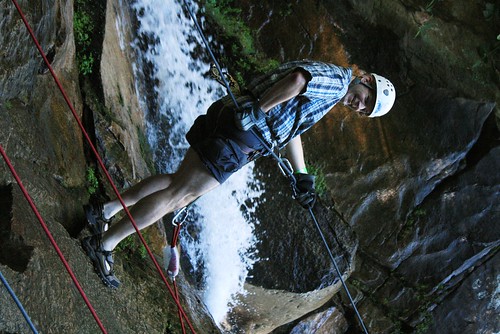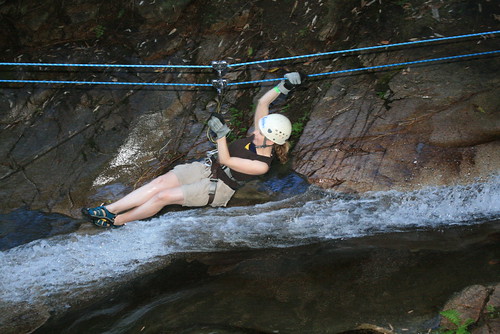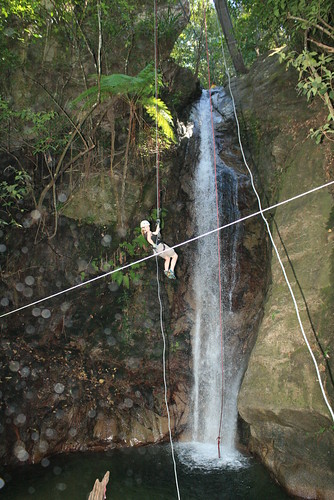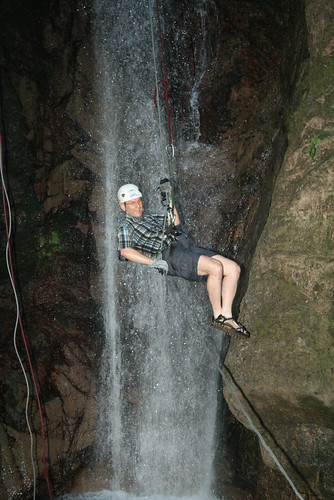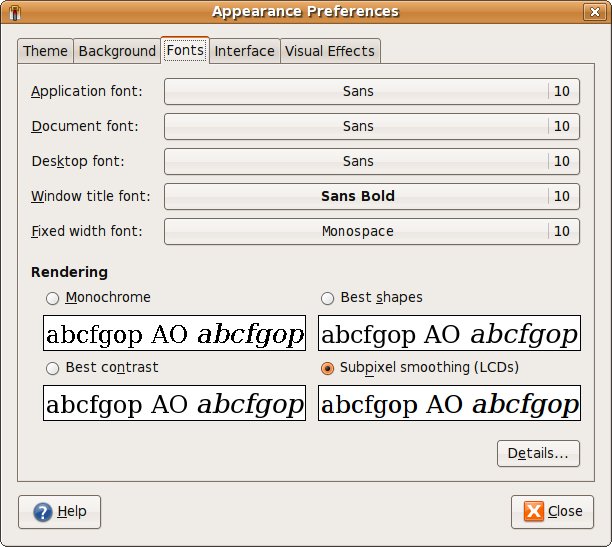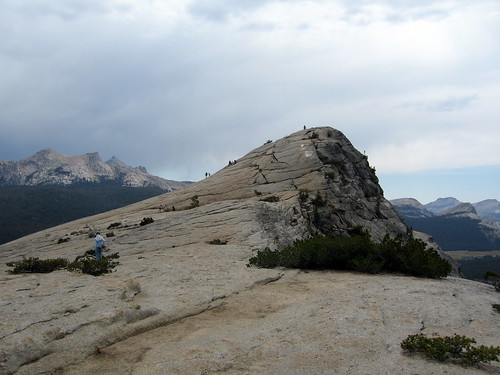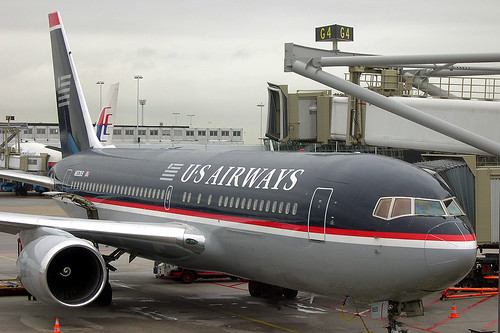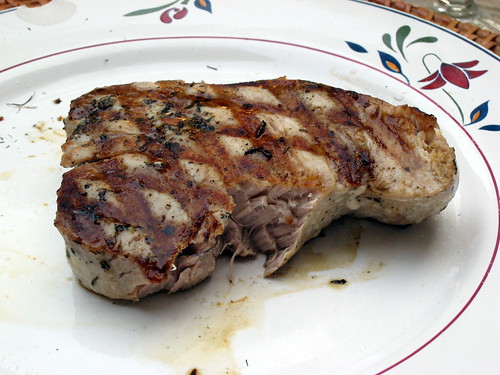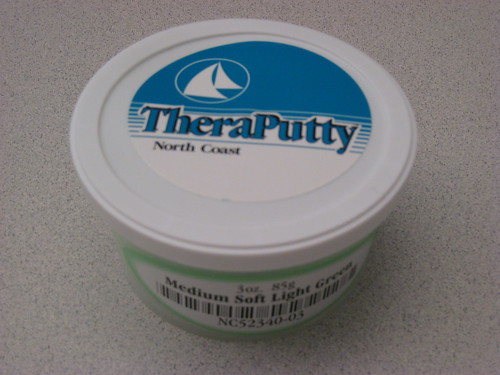February 02, 2010
Zip Line and Rappelling Adventure in Puerto Vallarta
A few weeks ago, Kathleen and I went on our first cruise together. It was her fifth and my first, so I got to experience a lot of new things. If time allows, I'll try to write about that in the future. But for now, I want to talk about one of our shore excursions.
Our first day in port was in Puerto Vallarta. The weather was absolutely perfect: a few scattered clouds, light winds, and about 80 degrees with bright sun--a far cry from the storms in California. We disembarked from the ship and met up with a group who were all going on the same excursion. We were then taken to what I can only describe as a "speed raft" designed to carry about 20-30 people. We boarded the boat and were treated to a high speed ride of roughly 20 minutes across the bay to a small beach and dock area.
The cruise across the bay gave us some view of very nice water-front houses. It appeared as though there are a lot of wealthy folks that decided to build vacation homes there.
At the dock across the bay, we got off the boat and were lead a few hundred feet to a guide that instructed us to board one of two 4x4 trucks outfitted with benches in the back. The trucks took us on a 15-20 minute ride through the town and into the forest and up to a higher elevation, ultimately arriving at the "base camp" for the operation.
There we were asked to leave behind anything we didn't want to get wet. That meant cameras, wallets, phones, etc. They repeatedly warned us that we'd be getting very wet. We were also told, much to our surprise, that we wouldn't need bug spray or sunscreen. Most of our time would be in the shade of trees.
After depositing our belongings to a communal bag that would be placed into a secured locker, guides helped get us suited up with our harnesses, helmets, gloves, and other gear. Then we were lead to small set of benches where the guides were introduced in a fairly comical fashion and they spent some time teaching us three important signals: speed up, slow down, pull your legs up. We were also instructed on proper hand placement on the zip line, posture (holding your legs up a bit), and braking techniques.
(I noticed during the introductions that there was roughly a 1:2 ratio of guides to participants.)
After that was out of the way, we headed over to stables where each of us was paired up with a mule for a ride up the path that leads to the top of the course.
The mule ride up was probably 15-20 minutes and ended near the base of the first rappelling platform. There we did some brief stretching, reviewed the signals, and had a chance to ask any last minute questions.
Then it was time to climb a short hill up to the first platform. This platform, unlike others we'd see later, was large enough to handle the entire group, so we could watch the procedure for getting hooked on to the lines. One of our guides went first so we could see what everything looked like--and that it was possible to arrive at the other end safely.
Ready to Go
After the first guide went across (he was on the other end to unhook us and catch us if we arrived a bit too quickly), the line of participants stepped up the the ropes, one at a time. One would get hooked up, checked, and then was told to go. While one was zipping, the next person would be hooked up and released once the first one was safely on the remote platform.
The first zip was reasonably long but a fairly shallow slope, so you couldn't get going too fast even if you didn't brake to slow down. I decided to see how fast I could get going before I felt like I should slow down. It turns out that it wasn't until I was approaching the platform and got the "slow down" signal that I needed any substantial braking. I did "tap the brakes" a couple times just to prevent myself form turning, since that's the only way to keep yourself facing forward as you go.
I arrived at the platform, stopped, and was unhooked.
"How was it?" asked the guide.
"Awesome!" I said.
I knew the rest of the day was going to be a lot of fun...
From there we went on to the second platform and were treated to a slightly faster (steeper) line and some more interesting scenery. Beyond that, I forget exactly how many more lines we did before coming to what the called the "assisted vertical zip", which I can only describe as a zip line on a 45 degree angle. It's "assisted" because they thread an additional rope through the harness is such a way that the guide down below (you drop down 80 feet or so) can adjust your descent rate.
Rappelling Fun
That got us to the point at which we could start our rappelling adventure. The guides swapped out a bit of gear on our harnesses and then lead us to the place from which we'd be rappelling--a waterfall.
There we two lines going down, so one person could be going down on one while the other was getting hooked up on the other. Both lines terminated in the pool of water at the bottom of the waterfall. The water appeared to be a few feet deep, but it was hard to say from the top.
They reviewed the techniques before letting us go down (of course) but before I knew it I was hooked up and "walking" down the rock face on the line nearest the waterfall. When I got to the bottom, I discovered that the water was about 2.5 - 3.0 feet deep--just enough to get my lets wet and touch the bottom of my shorts. I figured that's why they made the point about everyone getting wet--since they know we're going to "land" in the water and it may be high or lower depending on the waterfall. Plus you get wet from the waterfall itself if you went down on the line nearest to it.
It wasn't long before I discovered how wrong I was.
Splash Down!
One of the next zip lines we encountered was fairly short--maybe 150 feet long. But it started at the top of a set of rocks and carried you over those rocks (barely missing them) and then over another pool of water. However the zip line continued to descend until it reached the edge of the pool, which meant that using that zip line would get you REALLY wet.
I watched several folks ahead of me splash down into the water, some exclaiming because of the temperature (mountain water is always cold, right?). When it was my turn, I asked the guide if I needed to brake. He said it'd probably help but I didn't NEED to. So decided to go full speed down the line. Needless to say, I impacted the water and splashed down pretty well. Like most of the folks before me, I was SOAKED.
It was around then that I remembered that I had accidentally left my wallet in my pocket. Oh, well. I enjoyed the ride and the cold water actually felt refreshing to me.
Where is everyone?
After one of the next zips, Kathleen and I managed to get a bit behind and briefly separated from the group. But there was a path to follow, so we just went along expecting to meet up with everyone else.
Except that we didn't. Instead, we arrived at another platform with nobody there waiting for us. We saw some people in the distance (headed away) and called to them but they didn't hear or notice us. It was then that we realized we must have taken a wrong turn somewhere and were officially lost. In the Mexican forest.
We talked about backtracking or maybe crossing the water below us and continuing on that path, but we ultimately decided that it was probably best to sit tight and wait for the guides to notice we were missing and come find us. Surely this happened before and they know where to go looking, right?
Luckily that worked just fine. We didn't wait there more then 10 minutes before a pair of the guides appeared and asked what we were doing there--even joking about the two of us sneaking off for some "alone time" (if you know what I mean). They led us across the water on a rope and across another one before reaching the next spot where we met back up with the group.
Down we go!
Not long after that we came to the vertical descent. It was affectionately referred to later on by several folks as "walking the plank" because we'd walk out on a metal walkway, suspended about 70 or so feet above another pool of water, to reach a slight larger metal platform. There you'd be hooked up to a rope and instructed in how to use your had on the rope behind you to control your rate of descent. One of the guides down below also had a rope they could use to assist if you had trouble.
I'm not sure why this freaked some people out as much as it did. It was like a more aggressive form of the "assisted zip line" where you get more control. I had fun going down when it was my turn! (Even if my hand did slip a bit.)
We had a few more zips after that and before long it was time to hike back to the base camp. Our route back took us across numerous small streams. Often there were overhead ropes installed so you could hang on as you crossed in case you slipped on a rock or had balance problems. It was a nice way to wind down the day.
Finishing Up
Back at the base camp, we traded in our helmets, gloves, and harnesses for our stored possessions, washed our our shoes and had a chance to use the restroom. Then we had a bout 20 minutes to peruse the photos (see note below) and munch on some snacks. It was mid-afternoon and most of us hadn't eaten since breakfast, so the snacks were most appreciated! I especially enjoyed the chips and fresh salsa.
Hunger conquered and pictures purchased, it was time to hop back on the trucks for a ride down the hill and back to the boat that brought us across the bay. There were two very important differences about the ride down compared with the ride up. First, it was much faster. The diver took full advantage of gravity, so made good use of the seat belts and the overhead "oh, shit!" straps. It was quite a ride!
Mmm. Tequila!
The second difference is that we had a stop on the way back.
At a tequila factory.
For a tasting.
Yay, Mexico!
I really didn't know anything about the differences between types of tequila--that some are intended for use in drinks like margaritas while others are made for sipping (like a scotch, I guess). And I most definitely didn't know that flavored varieties like "almond" and "chocolate" existed!
I must say that the almond tequila was the best tequila I've ever had the pleasure of trying. And it's easily near the top of my list for "sipping" alcohols. The taste was just fantastic--very smooth. In retrospect, I should have bought a bottle or two to bring home. But at the time I figured they were a bit pricey and we might encounter other sources during our time in Mexico.
That may be my only regret about the entire trip.
Anyway, after the tequila tasting, we proceeded back down to the small beach and boat dock, hopped back on the "speed raft" and got a nice ride back to the ship.
Conclusion
All in all the excursion was a great time. We really enjoyed the zip line and rappelling experiences, all the modes of transit (boat, 4x4, mule), excellent weather, great scenery, and friendly people.
Note on Photos
Since we didn't take a camera along, I should note that all of the photos in this post and in this Flickr set were taken by the photographer "guide" who was on the course with us. She did a good job of capturing some of the scenery and nature along with each of us in varying states of descent on both zip lines and rappelling. We purchased a CD of the pictures at the end of the day. It contained all the photos of either one of us we found (starred them in Picasa) as well as all the scenery and nature shots she took that day. I was VERY COOL of them to give us the digital versions rather than trying to sell prints or something stupid like that. Thanks to Vallarta Adventures for being forward thinking.
January 30, 2010
Paper vs. Screen
I arrived at the Knoxville, TN airpot a bit ago for my slightly delayed flight back to San Jose via Dallas. Since I finished my book on the flight(s) out, I stopped by one of the shops to do something I rarely do: buy print media. Well, I still buy books now and then. But today I bought a couple of magazines: Disocver and Business Week.
I sat in the Ruby Tuesday's at the airport and managed to read a few articles in Business Week. After a bit I noticed that I was reading stories that I'd probably never read on-line. My on-line reading tends to be a lot more focused and directed. Reading for at a relaxed pace for pleasure is a whole different feeling.
It makes me wonder what I'd do with a Kindle or iPad if I had one. Would I use it the same way I read on a computer? Or would it be more like reading a magazine?
Hard to say. I have no plans to buy either device, but in a few years when I replace my existing portable computing devices, odds are that I'll have something tablet-like.
I'm not sure I'd want to be in the magazine business a few years from now. I feel like it's following the "lead" (if you can call it that) of the newspaper industry.
Interesting times.
December 13, 2009
Weird Email People Send Me
I really have no idea what prompted this:
This is Rev.Willson and am interested in some of your Barrel. I need the Barrel in the specifications of 55 Gallon Barrel. Blue Plastic.So what will the total cost of the Barrel with the dimensions i gave and i need 100 quantities of the Barrel.So i will like you to go ahead and quote me the total charges of 100 quantities of the Barrel + tax without shipping charges included.Because i will be picking this up as soon as it is ready from your location.Please if you don't have the type of barrel that am interesting kindly email me back with the types that you have.And i will be very glad if you can also email me back with the types of credit card that you will accept for payment. Please advice. Thank You.
It's so random that it's funny.
October 11, 2009
Lazy Shopping Carts
What's with all the lazy shopping carts? It seems that through the years, shopping carts have become progressively more lazy.
Years ago, when a shopping cart was done with its duty, it had to find its way all the way back from your car to the store entrance--either just inside or just outside. But, apparently as the result of an aging population of shopping carts, grocery store designers started scattering "cart corrals" around the parking lot so that the poor carts only had to scoot a few dozen yards before coming to rest. But even that is starting to seem inadequate.
I was at Trader Joe's earlier today and noticed quite a number of carts that could only make it as far as the little curbs that surround the trees that in the parking lot. And at Safeway, where there seem to be cart corrals every 15 parking spots, I still see carts that aren't able to make it even that far.
Modern technology has done so much to our modern food system in the last 20 years (a fair amount of it quite questionable, I'm sure), yet so little has been done to help these carts! Why is that?
Who are the cruel people that insist on keeping these carts in service long after they're able to perform up to very basic expectations?
What is this world coming to?
It's sad, really.
August 10, 2009
Firefox vs. Google Chrome Revisited
Last week, in Google Chrome is the New Firefox, and Firefox the new IE, I ranted a bit about how slow Firefox 3 (notably tab switching and the "awesome" bar") was on my Ubuntu 9.04 machine. Needless to say, I got some good feedback from that post and it prompted it me to do a few things.
I've since been running both Firefox 3.5 as well as the Firefox 3.6 trunk code and can say that both are notably faster than Firefox 3.0.xx. The difference between 3.0.xx and 3.5 was substantial and really helped to close the gap with Chrome. Going to the 3.6 alpha nightly builds made it even faster in some places and slower in others--not surprising since it's still in development. Scrolling was drastically worse, but I'm told that's currently in flux.
I have to hand it to the Firefox team. They're not taking Chrome lying down. I've found no real issues with running 3.5 so far and it's a bit of mystery to me (which is to say "I haven't researched at all...") why Ubuntu 9.04 isn't upgrading folks to it. I'm really looking forward to seeing 3.6 stabilize. The Javascript and layout performance seems really good in my use so far.
February 11, 2009
White House CTO? Bigger fish to fry first...
Over on the Sunlight Foundation blog, Ellen Miller asks White House: Where is the CTO?. Pardon my bluntness, Ellen, but what are you smoking? Don't you think there are higher priorities right now?
It seems to me that Obama and his administration have their hands more than full working on the economic problems we're facing along with rebuilding some of our important international relationships. I'm as much of a technology geek as the next guy, but it really won't bother me if the punt on the whole CTO thing for a few months while some of the bigger fish are fried.
I can't say quite why, but this call for immediate action on a CTO feels like a bit of headline grabbing and irresponsibility at the same time. Sure, they could come out and name a CTO tomorrow and I'd applaud the move. But I really hope they're keeping their priorities in check. Part of being a good leader is deciding what can wait and what cannot. Appointing a CTO can wait. Fixing our economy cannot.
Update: It looks like Kara has jumped on this too.
December 30, 2008
Twitter as a Dynamic DNS Service
I occasionally wish to know the IP address of my home Cable Modem or DSL connection but don't really care if it's available in DNS or not. It occurred to me that if I could programmatically detect the IP change, I'd be able to notify myself via Twitter.
At first, I wanted a simple web service that'd tell me my IP address--something like WhatIsMyIP.com but an API suitable for simple scripting.
Not finding anything, I created this massive PHP script instead and hosted it on my server:
That made it easy to write a simple bash shell script that can be run from cron every few minutes. It uses curl to hit that script and compares the result with the previous result (stored in ~/.last_ip). If they differ it updates the file and tells twitter, again using curl.
Of course, I had to create that new twitter account and then follow it in my main account. But, hey, that wasn't so hard. Now I have a Web 2.0ish social dynamic DNS thingy that uses Twitter.
Aren't I cool and buzzword compliant?!
November 23, 2008
Opa! is Good Greek Food in Willow Glen
A month or so ago, the long under-construction Opa! opened its doors on Lincoln Ave in downtown Willow Glen. Wanting to try it for a while, we walked down on Friday night for dinner. And we were not disappointed.
The Good
The menu is straightforward and has a good variety of Greek food. We ordered the Keftedes (Greek Meatballs) as an appetizer. The dish consisted of two well prepared meatballs and an excellent sauce.
For the main courses, we selected a Beef Souvlaki Pita (hers) and Seafood Souvlaki (mine). Both came with the most excellent Opa! Fries. (Think: garlic fries with a twist.) The food came in a reasonable amount of time and our waitress was very friendly and helpful. It was very tasty and portions were not excessively large either.
Their drink menu contains a selection of beers and a good selection of Greek wines as well. The wine we sampled was quite good and is apparently available at Costco. Needless to say, we're going to have to verify that for ourselves. ;-)
The interior is well decorated. I especially like the large TV monitor that shows what songs are playing over the sound system.
Pricing was reasonable. Dinner for two with drinks, an appetizer, and desert (Baklava!) was about $50. Not the sort of thing we do often, but definitely not out of line with other favorite eating establishments.
The Bad
Opa! is a small sit down restaurant with tables for 2 and 4 (mostly) that also handles to go orders. It's often very full and could definitely benefit from more space inside. As a result, the tables are fairly close together and the waitresses occasionally bump into customers. But space isn't easy to come by in Willow Glen's downtown.
More
Opa! has over 60 ratings and reviews on Yelp and is also discussed a bit on Willow Glen 2.0.
If you're looking for good Greek food in the area, I'd highly recommend giving Opa! a try.
November 17, 2008
TV Watching and Happiness
In one of those "well, duh!" moments the other day, I came across a headline on Slashdot that said Unhappy People Watch More TV. Given that I mostly stopped watching TV quite some time ago and consider it to be one of the more rude devices in our culture, I clicked thru to read about how others have discovered what I'd already guessed was true...
A new study by sociologists at the University of Maryland concludes that unhappy people watch more TV, while people who describe themselves as 'very happy' spend more time reading and socializing. 'TV doesn't really seem to satisfy people over the long haul the way that social involvement or reading a newspaper does,' says researcher John P. Robinson. 'It's more passive and may provide escape--especially when the news is as depressing as the economy itself.
Imagine that... Stagnation and exposure to negative information leads to sadness. It goes on...
The data suggest to us that the TV habit may offer short-run pleasure at the expense of long-term malaise.' Unhappy people also liked their TV more: 'What viewers seem to be saying is that while TV in general is a waste of time and not particularly enjoyable, "the shows I saw tonight were pretty good.
Another shock. TV provides only a short-term reward (kind of like a drug hit).
If this resonates with you a bit, or you suspect deep down that there's more going on with the influence of TV in our culture, I highly recommend reading Amusing Ourselves To Death by Neil Postman if you have not already.
It's too bad this stuff doesn't get taught in school--where, I'm told, teachers are using PowerPoint more and more.
*sigh*
November 13, 2008
Post-Election Thoughts: Equal but Not
I'm happy that Barack Obama won the election. I think it's time to stir things up a bit.
What really bothers me is that fact that we still don't have equal voting in this country. We certainly have the technology to share vote counts quickly and efficiently, so who not just do that? Why screw around with an electoral college anymore?
It seems disingenuous at best and an outright lie at worst to call Obama's victory a "landslide" when the actual percentages of the popular vote (the only vote that should count) were so close. Yet the large difference in electoral vote counts is supposed to make us believe that something very different happened. And the media was more than happy to play along with that deception (what a surprise, huh?).
It should not be possible to lose by having more votes than your opponent, but it is. Why does nobody seem to care? (See: electoral college, specifically this.)
Of all the countries that have tried to copy our model of democracy in the last 200 years or so, can you name a single one that adopted the electoral college as a piece of their political infrastructure?
I'd love to have my vote count as much as everyone in all the other states.
Why is that so hard?
October 22, 2008
Kick Ass Fonts in Ubuntu: 3 Easy Steps
A few days ago I made yet another tweak to my Ubuntu laptop to make the fonts look a little better. The result is that I'm now quite happy--impressed even. Here are the three things I've done to make my day-to-day work easy on the eye.
First, enable subpixel smoothing in the System > Appearance control panel.
For a long time that's all I had done was was reasonably happy. Things looked okay but not great. But I used GNU Emacs for most of my coding and wanted fonts there that looked at good as those in gnome terminal.
That led me to the second tip: install emacs-snapshot and use the GTK version. Then you can add this to your ~/.Xresources file:
Emacs.font: Monospace-10
And bingo! The same font that's in your terminal is in Emacs.
That made me happy in Emacs, but my Firefox fonts were still a bit sucky. So when I read Tweak Your Font Rendering for Better Appearance in Tombuntu, I had to give it a try.
I created a ~/.fonts.conf file and added this to it:
<?xml version="1.0"?>
<!DOCTYPE fontconfig SYSTEM "fonts.dtd">
<fontconfig>
<match target="font">
<edit name="autohint" mode="assign">
<bool>true</bool>
</edit>
</match>
</fontconfig>
I logged out and back in and suddnely found myself staring at fonts in Firefox that looked as good as I've seen in Safari on a Mac.
That's all there was to it for me: subpixel rendering, emacs-snapshot, and enabling hinting via a .fonts.conf file.
It's worth noting that you can go even farther with the advanced font settings, but I really haven't needed to go that far yet.
October 21, 2008
Random Updates
I've got several random things to say to the interwebs but none of them merit a blog post individually...
First off, I love data. But I hate the fact that the spreadsheet in OpenOffice 2.x and Gnumeric both have row limits of 65,536. I don't know who missed the boat on 32 and 64 bit CPUs, but it's rather annoying! And, yes, twitter people, I know that 65,536 is a 16 bit limit--not 8. I was trying to make a point.
Secondly, Yahoo can haz layoffs (again). Having lived through 3 rounds of layoffs in my 8.5 years at Yahoo, I know what that feels like. :-( If you're a kick-ass Perl hacker or an excellent systems and network administrator who'd like to work at a great company in San Francisco, let me know.
Thirdly, the dumbest bugs are often the ones that have been in your code a long time and are incredibly easy to keep glossing over as you read and re-read it.
Fourthly, Tie::Syslog is pretty handy but seems to not like being used multiple times in the same app. Each instance seems to think that it has the same "identity." Anyone seen that before? I haven't dug into that yet but probably will soon.
Finally, we're out of town for a few days while the house is being fumigated for termites. And we brought all four cats with us. That what I call an adventure.
Now back to your regularly scheduled... uh, stuff.
September 25, 2008
Ubuntu Kung Fu: Best Book Cover Ever!
I just ran across news that Ubuntu Kung Fu is Shipping and happened to look at the cover. As a cat lover and technical book author myself, I felt a little slighted.
That's right. Keir Thomas got a kitten on his book.
That kicks ass.
But even better, Ubuntu Kung Fu (PDF and printed) sounds like a real winner for day-to-day Ubutnu users. As the marketing blurb says:
Award-winning Linux author Keir Thomas gets down and dirty with Ubuntu to provide over 300 concise tips that enhance productivity, avoid annoyances, and simply get the most from Ubuntu. You'll find many unique tips here that can't be found anywhere else. You'll also get a crash course in Ubuntu's flavor of system administration. Whether you're new to Linux or an old hand, you'll find tips to make your day easier.
In other words, it's a book that nearly everyone using Ubuntu could benefit from. I'm hoping to grab a copy shortly. Have a listen to Keir Thomas on Ubuntu Kung Fu in this week's Pragmatic Podcast.
Also available on Amazon.com.
September 24, 2008
Mustard Lime Beef Steaks Recipe
A few days ago I made a new grill recipe that turned out even better than we expected, so I've reproduced it here for your grilling and eating enjoyment.
Ingredients
4 sirloin beef steaks (roughly 1" thick)
1/4 cup of dry mustard (Colman's works well)
1/4 cup Worcestershire Sauce (Lea and Perrins works well)
Lime Juice or 1 large lime
Coarse salt (sea salt is what I use)
Freshly ground white pepper
Preparation
Cover the steaks on one side with 2 tablespoons of dry mustard. Pat it down and spread evenly with the back side of a fork. Sprinkle two tablespoons of worcestershire sauce over the steaks, allowing it to soak into the mustard--patting the steaks with the fork if necessary. Dribble a bit of lime juice over the steaks.
Season the steaks with a good amount of salt and pepper. Then flip the steaks and repeat on the other side. Let them marinate for 20-30 minutes while pre-heating the grill.
Cooking
Clean and oil the grill. Cook the steaks on high heat for roughly 4 to 6 minutes per side, aiming to keep them pink on the inside. Do not rotate the steaks to make those nice cross-hatched grill marks. Doing so may knock off some of the mustard and seasonings.
Let the steaks sit for a few minutes. Slice and enjoy. :-)
Unfortunately, I have no pictures to show. But they're most excellent to eat. Trust me.
August 19, 2008
Lembert Dome Hike in Yosemite
Last weekend afforded an opportunity to explore the Lembert Dome Hike in Yosemite National Park.
Lembert Dome is the monolithic dome that dominates the eastern end of Tuolumne Meadows in Yosemite National Park. It's a justifiably popular ascent, particularly among day hikers in the area, with the summit offering magnificent views of Tuolumne Meadows to the west, the Cathedral Range to the south, and the Sierra crest to the east.
The trail starts out a bit steep but the views are definitely worth the trek up, as is a quick side trip to Dog Lake.
Here are a few pictures.

Some rocks to mark the start of the trial...

The clouds helped keep the heat down.
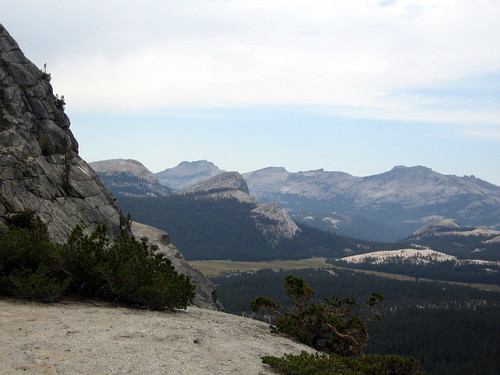
Looking back where we came from.
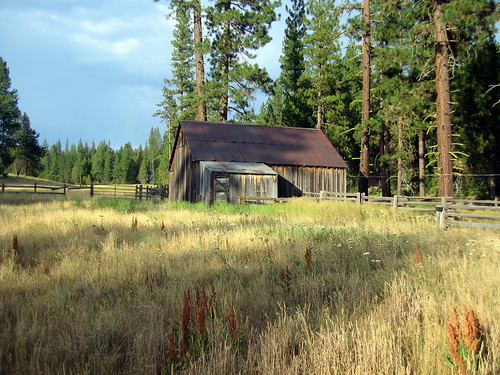
Farm near Evergreen Lodge (just outside the park)
The rest are here: Lembert Dome Hike in Yosemite on Flickr
July 17, 2008
The Truth about Web Navigation
In Will Mainstream Users Ever Learn About The Browser's Address Bar?, Marshall probes a bit into how people use the browser's search box vs. the address bar.
A lot of people seem surprised to learn that tons of people every day are "searching" for ebay.com or aol.com or just "ebay" or "aol" even though they can type those things into their address bar and get exactly what they want.
I think part of the problem is the myth perpetuated by the search companies themselves. They all know that the top search terms every year are not "britney spears" or "ipone" or whatever.
They're domain names or domain names without the .com on the end of them. Lots of people search Google every day for "yahoo." People search Yahoo for "google." And AOL. And eBay. And so on.
They all filter out those "navigational" queries when reporting those things. I'm not sure who they're trying to protect by doing so, but I certainly could speculate.
Everyone in the search business seems to mostly get this. The folks at those big destinations (like eBay) know this too. They have logs. But the rest of the techie population on-line seems to believe that normal people use the web the same we do.
They don't. And they never will.
Get it through your collective heads, please.
People don't get DNS, domain names, or the difference between searching and direct navigation. And since they all know what it means "to google" that's exactly what they do. You can either accept that or deny the truth.
That's why you're seeing numbers like this every quarter.
This ends today's reality check. Please go back to trying to change the world by explaining what the address bar is for. :-)
Oh, here's a bonus tip: normal people can't tell the difference between AdSense style ads and all the other links on most web sites. And almost the same number don't know what "sponsored results" on the Search Results Page are either. It's just a page of links to them. They click the ones that look like they'll get them what they want. It's that simple.
July 14, 2008
Weight Based Pricing of Airline Tickets
Ever since fuel prices have been on the rise, I've wondered why airlines don't price tickets based on weight rather than the current system where pricing is related to factors that few of us understand.
I mean, really, if it costs more to fly a 300 pound person than a 180 pound person, why shouldn't the 300 pound person pay more?
And by "300 pound person" I'm including the 200 pound person that brings 100 pounds of baggage along. That costs money to fly too.
We're sort of headed in that direction with extra costs for extra bags, but why not just go all the way? Make the pricing fair. Airlines can compete on a dollars per pound from point A to point B.
Clearly the airlines are desperate to save weight.
This might encourage people to pack less junk. That's save fuel costs, baggage handline time, and so on. It might even encourage frequent flies to think twice about eating that Cinnabon "treat" before getting on board.
Would that be so bad?
After all, when it comes to buying gas at the pump for our cars, we each pay for what we use. The people who are moving heavier loads (either themselves or their cars) buy more gas and the gas stations "compete" on a dollars per gallon basis. There's no flat fee to fill up a car based on when you decided you need to fill up.
Same with electricity. And water. And so many other things in life.
Let's pay the actual cost and no pretend that moving a 12 year old across country uses the same amount of fuel as her overweight 48 year old father.
Have there been airlines that tried this in the past? Did they end up only flying supermodels and skinny people around? Did people pack less baggage?
Update: See the comments on FriendFeed too.
July 09, 2008
Grilled Tuna Steaks Recipe
Yesterday night I made grilled tuna for the first time. And the consensus is that the results were mighty fine. So good, in fact, that paying restaurant prices for the fish was still worth it. (Yeah, tuna is a bit more pricy than I expected...)
Here's what you need to make the marinade spread:
4 peeled garlic cloves
1 tablespoon coarse salt (sea salt)
1 tablespoon dried oregano leaves
1 tablespoon dried basil leaves
1 teaspoon freshly ground black pepper
1/2 cup extra-virgin olive oil (possibly more)
4 tuna steaks (6-8 ounces each, roughly 1 inch thick)
8 bay leaves
And how to do it:
- Combine the garlic, salt, pepper, oregano, and basil in a mortar and grind it into a paste with pestle. Add the olive oil a bit at a time until you achieve the consistency o of a spreadable paste.
- Rinse the tuna steaks under cold water and blot dry with a paper towel. Then cover both sides of the tuna with the marinade paste. Put the tuna into a small baking dish or pan and add the extra olive oil. Flip the tuna to get oil on both sides and then add a bay leaf to the top and bottom side of each tuna steak.
- Cover the tuna steaks and refrigerate for 3-4 hours.
Finally, cooking instructions:
Rinse and dry the tuna steaks and then apply a little olive oil to both sides. Pre-heat the grill for high heat, brush oil onto the grill, and begin grilling the tuna. After 2 minutes, rotate the steaks 45 to 90 degrees for cosmetic grill marks. Grilling will take a total of 4-6 minutes on each side depending on thickness and taste.
The final product (once sampled) looks like this:
And it's quite good. :-)
Enjoy!
See Also: Using a 20 Pound Propane Tank with the Weber Baby Q Grill
July 07, 2008
Crazy Yosemite Squirrel
A few weeks ago we ended up hiking the Mirror Lake Trail in Yosemite National Park and encountered an amusing little squirrel near the end of the trial. I just happened to have finished filming a deer that walked nearby, so I pointed the Canon SD800 at the little furball to see if he'd perform.
Sure enough, he did. Check out the video.
I have no idea if this is common or not, but we were all amused at the little stretching thing he did at the ~40 second mark.
I also have some good photos of that hike (and the visit to Glacier Point) that should be coming online soon. Watch my Flickr photostream.
July 02, 2008
Two Tech Jobs: Technology Evangelist and Network Operations
I've been getting lots of inquiries from recruiters recently looking to find good people for various tech companies. Two in particular might be interesting if you're in the market or know someone who is.Technology Evangelist at New York City Based Startup
If you saw Fred Wilson's post Are You A Connector?, you know a bit about this job already. It's a NYC based startup developing a new platform in an area that's likely to see serious growth in the next few years.
They're looking for someone with coding experience who loves showing other developers and users how stuff works: on stage, via blogs, in screencasts, and so on. It's important that this person have a technical (programming) background and also be very comfortable getting in front of people to demo and speak.
The company is New York based and this job is too. However, I'm told that a Bay Area candidate may work as well, since a presence here will be important. Otherwise, I'm sure that frequent travel to the Bay Area will be part of the gig.
The company is still a bit stealthy but more information will be forthcoming soon.
Ping me if you're interested and I'll put you in touch.
Network/Systems Administrator at Rapleaf in San Francisco
The folks at Rapleaf ping me from time to time looking for talented engineers too. Here's the description of the position they're currently hiring for.
Rapleaf is a well-funded San Francisco startup (weíre currently at 15 people). We gather publicly available information from the social web on hundreds of millions of people to enable developers and companies to give their consumers a better user experience. Rapleaf has built the largest portable social graph in the world. We provide rich insight on customers for clients such as retailers, airlines, hotel chains, social networks, lead gen firms, telcos, political campaigns, financial services, and more (these companies learn about their consumers in order to give them a better user experience). The company has processed over 175 million unique searches for businesses and consumers.
You will maintain Rapleafís entire infrastructure and enhance the system to do great things as weíre on the trajectory to change the world. Helping grow one of the largest and most complex databases for a small start-up.
Role:
- Manage all Rapleaf servers (Linux Ė CentOS, Redhat), backups, web servers (Apache clusters)
- Manage relationship with hosting provider and hardware vendors
- Scalability and expansion (Hadoop)
- Systems administration (DNS,LDAP,NFS,TCP/IP,SELinux)
- Some scripting (Shell, Ruby, Python, or Perl)
- Administer MySQL databases (multi-master replication, snapshot backups)
- Learn how to scale with Ruby on Rails
- Manage complex Java systems
- Manage billions of data items of pages being served
- On-call duty
Note: this job is really hard. Youíll be working with some of the top search engineers in the world and they are going to expect that you kick ass. Weíre doing things that no one has ever done before and solving problems that have been open for years.
Qualifications:
- Master of all things Internet and Linux.
- Incredibly smart, can learn fast, and takes no prisoners
- Learn new platforms fast. We use Ruby on Rails and Java Ö you can pick this up quickly.
- Intensely driven and proactive person.
- Extremely hard working. This is a start-up - team members work long hours.
- Quick learner and real doer. Err on execution over strategy.
- Thrive on working with A-players. Too good to spend long hours with B-players.
- Likeable person who garners respect on and off the job.
- Thrive on chaos, risk, and uncertainty.
- Should be easy to get along with, nice, fun, smart, ethical, and low-maintenance.
- Strong desire to build a more ethical society.
- Desire to be an early employee and want to be a real owner in Rapleafís future.
- Want to work with extremely large datasets and indirectly build portable APIs that thousands of other companies can build applications on top of.
- Ability to lift and install servers (50 lbs)
- Should want to live in or near San Francisco (relocation available if necessary)
Perks:
- Good salary/stock compensation.
- Personal MacBook Pro or Linux based machine
- Medical insurance, 401k.
- Kitchen stocked with food
- Work with some of the smartest engineers
- Contribute to the Rapleaf Dev blog (http://blog.rapleaf.com/dev/)
Again, ping me if you're interested or know someone who might be. I'll make an introduction for you.
June 17, 2008
Back up in your ass with the resurrection!
It's hard to explain the appeal of Office Space if you don't already get it. Therefore its even harder to explain how funny the first set of comments in response to this link on reddit.com is to me.
[Hint: the full sized image is easier to read.]
Seriously, I'm already a fan of both Office Space and Reddit. But now I love each one just a little bit more.
Feel free to insert your favorite Office Space quote in the comments below--unless you're a no talent ass clown like me, that is.
Damn it feels good to be a gangster.
In related news, Get Firefox 3 Today. I did. You should too.
May 13, 2008
Good Food, Eating, and Diet Advice Talk by Michael Pollan
I've been a fan of Michael Pollan's work for some time now, so I was quite happy to run across a video of a recent talk he gave at Google in which he discusses the current understanding of food and nutrition as well as what's wrong with our "system" today.
Even if his name doesn't ring a bell, you may have heard of some of his books: In Defense of Food: An Eater's Manifesto, The Omnivore's Dilemma: A Natural History of Four Meals, and Food Fight: The Citizen's Guide to a Food and Farm Bill.
Anyway, enjoy the video.
And, if you found that interesting, allow me to resurrect my 2+ years old diet posts. They seem to still garner a fair amount of attention, and recent readers may not have been reading when I first wrote them.
- Diet Tips or How To Lose Weight with a Spreadsheet and a Web Site
- The Diet Plan and The Three Habits
- The Diet Spreadsheet
- Diet Tips: How To Eat Less
- Diet Plans and Goal Setting: How Many Calories?
- Closing Diet Tips and Advice
May 05, 2008
Open Source Nonsense: Microsoft and Yahoo Flamebait?
Writing on OStatic, Reuven Lerner (whose writing I've read in various places over the years) appears to be hitting the crack pipe in explaining how he wonders if Microsoft buying Yahoo would lead to Yahoo ditching open source projects.
Huh?
That's what I thought. Here's what he says
Back when Microsoft announced its intention to buy Yahoo, many of us wondered whether Yahoo would be forced to get rid of its open-source projects in the wake of such a purchase. But after reading the press releases put out by Yahoo, in which they seem to indicate that they're aiming not only to survive, but to become a stronger and more profitable company, I have to wonder whether this might force Yahoo to give up some of its open-source projects.
While it's not at all clear who "us" is there (open source community? OStatic writers? Israeli developers?), the implication that Open Source is somehow more expensive could use a bit of support. But let's go on and look for it.
My reasoning is as follows: Yahoo is not as profitable as it needs to be, which means that they begin to shed low-margin business units. Yahoo has already indicated its willingness to give much or all of its advertising business to Google; this presumably means that everything is on the table.
Okay...
While it's undoubtedly true that open-source software has many benefits, we have yet to see an obvious indication that development (and giving away) open-source software leads to higher profits. Indeed, while we cannot pin Sun's steep decline in the last quarter solely on its embrace of open-source software, the correlation seems too strong to ignore. Which means that if Yahoo is looking to restrict itself to profitable ventures, they might stop funding some of the open-source projects they have supported until now.
Huh?!?!
Hadoop is critical to many business operations within Yahoo, including Yahoo Search. Based on what the folks from that team have said, I find it hard to believe that getting on board with Hadoop was more expensive than rolling our own (again). And lower expenses often lead to higher profits, right?
And then there's PHP, another very important piece of infrastructure at Yahoo. It replaced a dozen other half-baked languages years ago. Maintaining a single server-side scripting language is far less expensive than a dozen that all suck more than PHP.
I could go on. But let's keep reading...
He then ends the article by saying the following, which really should have been at the beginning so that people wouldn't waste time hoping for a well thought out argument.
I should note that what I'm writing is pure speculation: No one at Yahoo has even hinted that their support of such projects as YUI and Hadoop will go away. And indeed, those tools are essential to Yahoo's future, which means that we can expect them to continue to survive.
I think there's a damned good reason that nobody has hinted that way: It'd be stupid to do so.
I've generally been pleased by the quality of writing at thinking on the GigaOm blogs. But this one really leaves me scratching my head. Was this supposed to be some kind of Open Source flamebait
April 30, 2008
Explaining the Cognitive Surplus
I really enjoyed watching Clay Shirky's talk on Cognitive Surplus at the Web 2.0 Expo last week. He does such a good job at explaining how and why watching TV is no longer the de-facto spare time activity that I'm going to simple force people to watch it when they claim not to understand how I have no time to watch television.
See for yourself...
It occurs to me that people like me, meaning generation X (as we're called), are part of possible the last generation where hours of TV watching every evening was a truly universal activity.
Even if I had a Tivo, I probably wouldn't find the time to really use it.
I've always enjoyed Clay's presentations and this one is no exception. Carve yourself out 15 minutes of whatever it is you'd normally be doing and give it a listen.
April 28, 2008
How to Get Rich with Green Putty
I realized something amusing today. If you take a 3 ounce wad of putty (just enough to put in your hand and squeeze it), color it green, and put it in a little plastic container, you can call it TheraPutty and sell it as a hand therapy product in hospitals and medical offices.
As far as I can tell, the key is to make it an unmistakable shade of green.
The trick to getting rich is selling this 50 cents worth of putty and plastic for just under $8.
And, in related news, I've posted my first video to Flickr.
I have the fun of spending about 5 minutes doing that 3-5 times a day--along with a few other finger strengthening exercises. Believe it or not, my finger is healing up pretty well so far.
April 13, 2008
Twitter Badge?
I'm using twitter more now that I'm trying to type less.
That makes me wonder if it's worth sticking a Twitter Badge on my blog.
Thoughts?
BTW, my finger is getting better every day. I can't wait to start flying again!
March 20, 2008
Asking as a Substitute for Thinking
 Reading the comments to Patterns for email as work conversation, I came across a comment that hit on something I see all too often (and am certainly guilty of myself):
Reading the comments to Patterns for email as work conversation, I came across a comment that hit on something I see all too often (and am certainly guilty of myself):
Iím definitely trying to get people used to the idea that I may only answer e-mails during two periods a day, but that if they have something quick, Iím available via IM. The issue really revolves around that I need some uninterrupted/uninterruptible chunks of time during the day or I feel like I have ADD, bouncing from issue to issue. Also, to a certain extent, I find that the people who work for me will, if Iím available, use asking me something as a substitute for thinking (this Iíve learned after years of being instantly available and then wondering why the people working for me donít seem to be developing critical thinking skills).
It's really, really tempting when you're busy and heave deadlines looming to just ask the guy (or girl) who you know will know the answer. Sometimes it doesn't even enter your thinking because you're focused on accomplishing something else. And it's equally hard to estimate the impact of your interruption on their productivity, concentration, and focus.
The real trick, I think is finding a way to handle this that's polite yet firm. And when you're the sort of person who's more apt to say "yes" than "no" when someone asks for help, it's difficult to help coworkers understand that you'd rather they learn to fish instead of coming to you for one when they're hungry.
Do you run into this very often? If so, how do you handle it?
March 17, 2008
In New York City for the Business of APIs Conference
 I tried to post this late last night but my laptop managed to freeze up on me. Gotta love this modern technology, no? And this morning the hotel Wifi is still down and my EVDO card is struggling to keep up with me. And there's some crazy jackhammer work going on outside that's been driving me nuts all morning too.
I tried to post this late last night but my laptop managed to freeze up on me. Gotta love this modern technology, no? And this morning the hotel Wifi is still down and my EVDO card is struggling to keep up with me. And there's some crazy jackhammer work going on outside that's been driving me nuts all morning too.
Yay!
Anyway, I'm in New York City today for the Business of API's Conference at the Yale Club, which sounds way fancier than anything you'd normally find me at. At about 1:30 eastern time I'll be speaking for about 20 minutes about Yahoo!, Openness (as recently noted), APIs, and that sort of stuff.
If you're at the conference and happen to see this, please do introduce yourself.
I'd love to meet up with other folks in NYC, but this is an unfortunately short trip. I'm flying back to the Bay Area on Tuesday morning to get some stuff done at the office in the afternoon.
We've got a lot to do before the Hadoop Summit next week.
But at least the weather appears to be nice, even if I don't have a good view out from my hotel room.
My goal for this trip is not adapting to the local time zone, so that I can get back to normal soon after my arrival back home. Let's see how well that works in practice...
Lastly, I may be playing around with FeedBurner soon. But that should be mostly transparent to subscribers--aside from a maybe a one-time "reset" of what's in my RSS feed. More on that when it happens.
March 13, 2008
Job: Architect/System Architect at Time Bridge
There's a job on my job board that some of my readers may find interesting. I won't quote the whole listing here, but Architect/System Architect at Time Bridge could be a fun role for someone who wants to get into the world of Web 2.0 business applications.
We are looking for a seasoned System Architect who is passionate about building truly useful Web applications. You will be a key member of the technical team that will design and build the companyís next generation system and you will play a foundational role in delivering a new platform to increase productivity and collaboration around scheduling, managing time and holding meetings. To succeed in this position you must be incredibly smart, committed to good technical design, and driven to get things done. You will work closely with senior management and talented marketing and technical staff. As System Architect, you will be primarily responsible for the architecture of our meeting scheduling system and for driving innovation throughout the product. The right candidate will have experience with multi-platform applications, will understand and have designed distributed, high-availability systems, and will have the vision to understand how small technical details affect the way users see and experience the end-product. This position will report directly to the VP of Engineering and Operations.
Disclosure: The VP of Engineering and Operations at TimeBridge is a former colleague.
From what I've heard about the company, they're doing some very good work there. Check it out if you're at all interested (and qualified).
As a reminder, you can browse all the jobs on my job board and post your own quickly and easily. They'll appear on my sites and other popular technology sites in the network. There's even an RSS feed for the jobs.
Also, special thanks to the folks at TechCzar for their translation of selected posts from my blog and including them in their growing blog network.
March 10, 2008
The "No Laptop" Meeting Rule
 I'm not about to call this a trend yet, but I've seen a few meetings at work in recent months that advertised and enforced a "no laptop" rule.
I'm not about to call this a trend yet, but I've seen a few meetings at work in recent months that advertised and enforced a "no laptop" rule.
Part of me thinks that it's a great idea. There are meetings I've almost skipped or found fairly useless because a significant proportion of the people in the room were suffering from continuous partial attention and often seemed lost or constantly behind the curve.
Another part of me thinks that it's absolutely ridiculous that we have to mandate common courtesy and force people off their laptops long enough to have a useful meeting.
I wonder what, if anything, schools (mostly college) are doing to help ensure that this isn't a problem in the workplace as more and more students start working full-time. Do they know how to put away the laptop or cell phone when the time comes?
Maybe the problem is that the people "at the top" of many companies set a bad example, walking down the hallway with their eyes glued to a Blackberry screen or constantly plugged into a Borg-like bluetooth headset.
Have you seen "no laptop" meetings starting to emerge in your organization yet?
